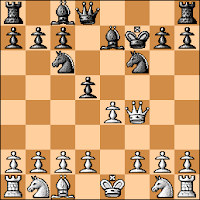
The story of "the Kentucky Opening" (see Part 1, Part 2, Part 3, Part 4), 1.e4 e5 2.Qh5 – which Joseph Henry Blackburne, I believe, likened to the Jerome Gambit (1.e4 e5 2.Nf3 Nc6 3.Bc4 Bc5 4.Bxf7+) in his Mr. Blackburne's Games at Chess (after 4...Kxf7 5.Nxe5+ Nxe5 6.Qh5+) – can stand one more chapter.
In a post about the opening, which he referred to as the Danvers Opening, Bill Wall (see "The Kentucky Opening (Part 3) ") wrote
It is mentioned in the American Chess Bulletin with that name in 1905
Indeed, it is:
American Chess Bulletin
June 1905
ALL BOSTON VERSUS NEW ENGLAND
One of the largest gatherings of chess players ever brought together in Boston witnessed the struggle for supremacy between teams representing Boston and vicinity and the rest of New England at the rooms of the Boston Chess Club, 241 Tremont Street, on May 30. Boston won by 29 games to 11, the winning team being headed by such well known players as John F. Barry, A.M. Sussmann and Dr. E. E. Southard...
A special prize was offered for the best game at the "Danvers Opening," viz., 1 P-K4, P-K4; 2 Q-R5, which will probably go to Dr. E. E. Southard, the noted ex-Harvard champion, who adopted it successfully against his opponent.
The following month, the American Chess Bulletin gave the score of the two "Danvers Opening" games from the Boston vs New England event, McClure, - Mathewson (1-0, 42) and Southard - Hill (1-0, 27), which were presented in "The Kentucky Opening (Part 4)".










